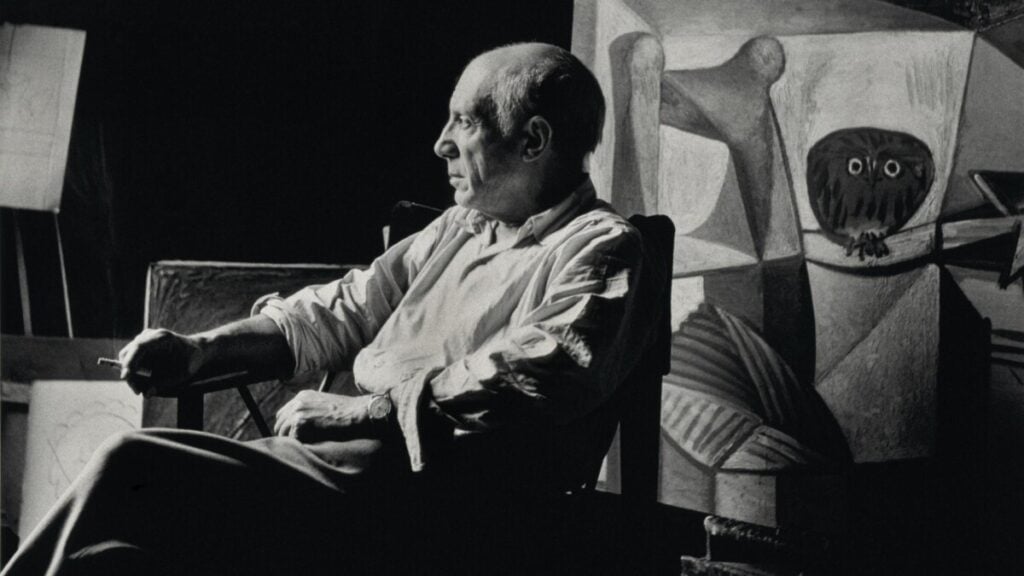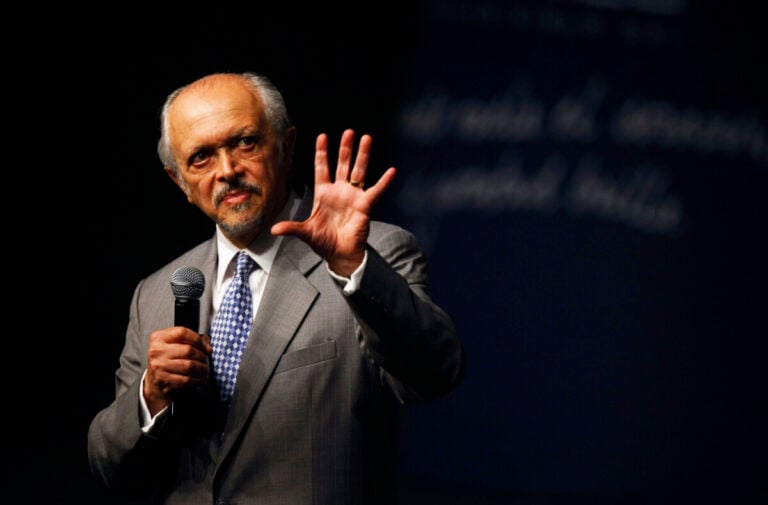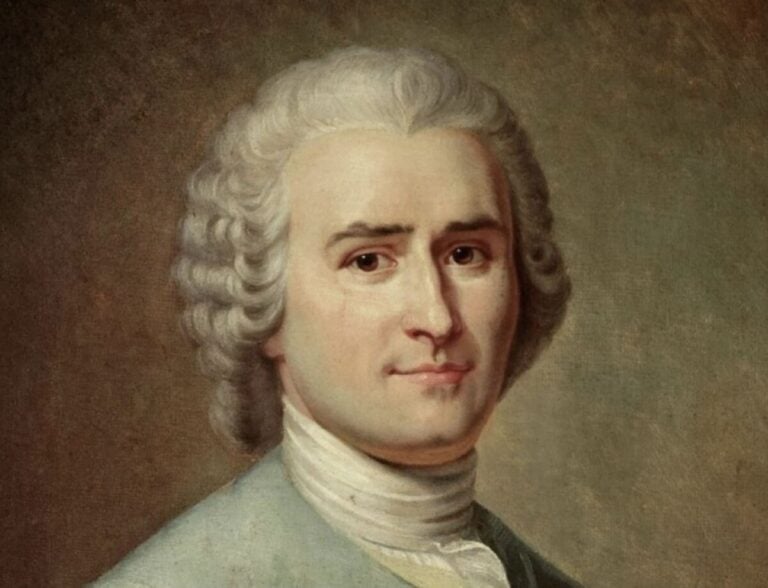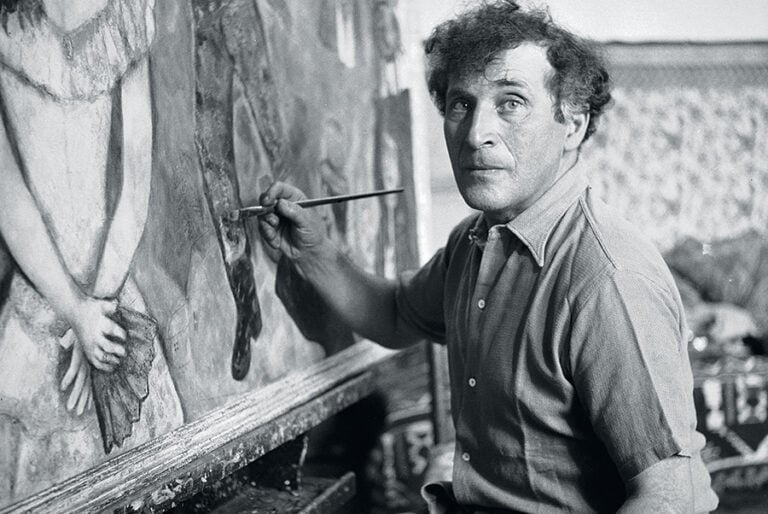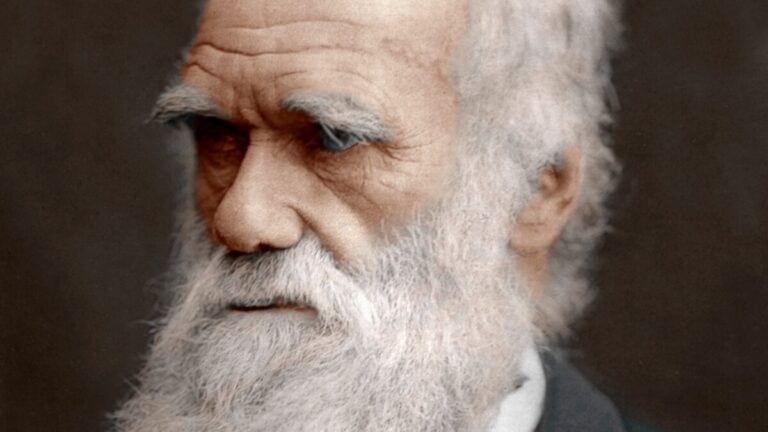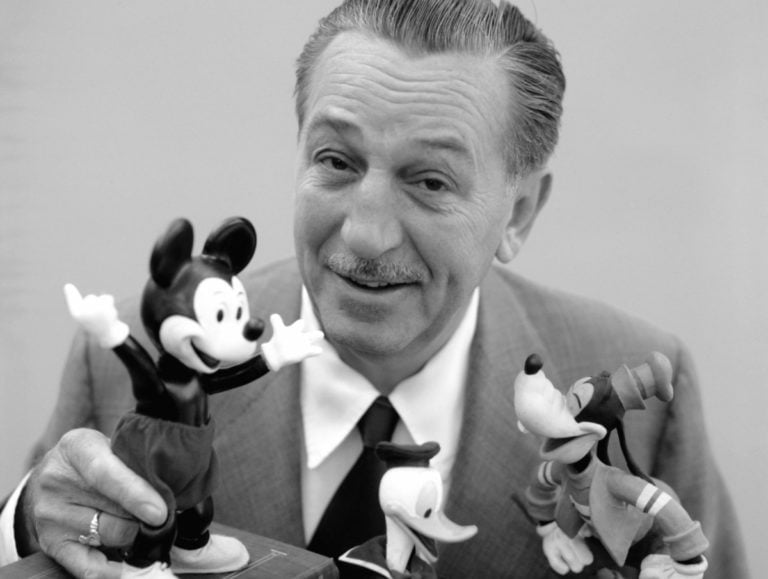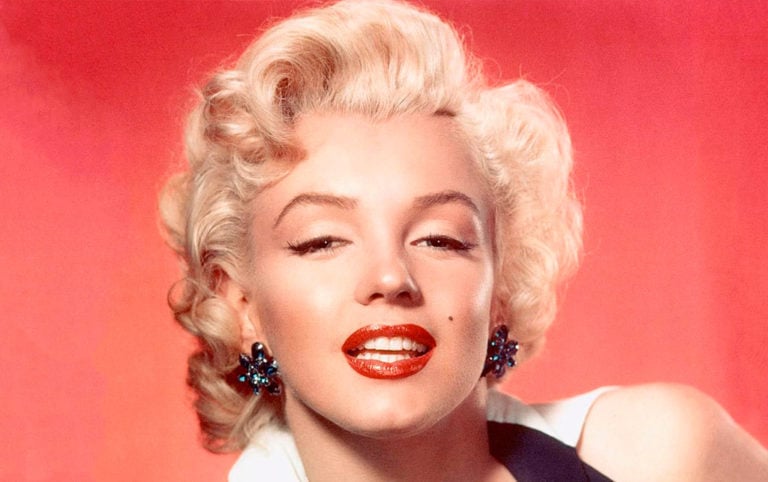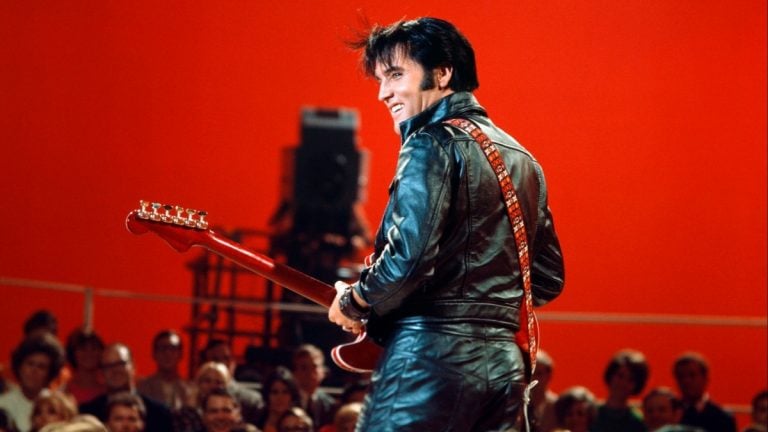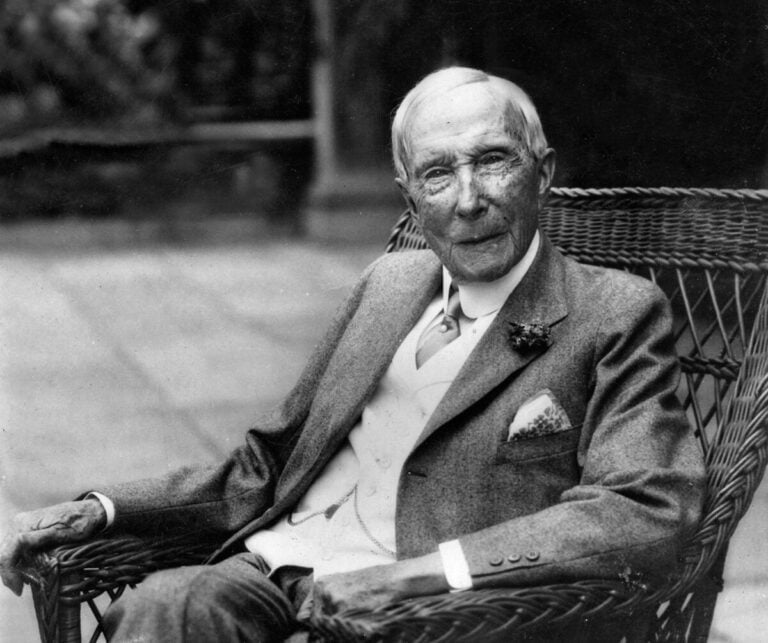Pablo Picasso (1881-1973) is an outstanding Spanish artist, engraver, sculptor, who lived in France for a long time and made a tremendous contribution to the development of world fine art.
- Childhood and youth
- Career
- Blue period - from 1901 to 1904
- Rose period - from 1904 to 1906
- Primitivism and African art - from 1907 to 1909
- Synthetic Cubism - from 1912 to 1919
- Surrealism and neoclassicism - from 1919 to 1929
- “The Great Depression” - from 1930 to 1939
- World War II and the post-war period - from 1939 to 1949
- Later works - from 1949 to 1973
- The Death of an Artist
- Politics in the life of Picasso
- Technique and style
- Personal life
He is the founder of the progressive trends in artistic painting of the 20th century, the cubist movement, exclusive style formats, as well as unique collage and sculptural techniques. The most famous paintings of this artist are “Les Demoiselles d’Avignon” and “Guernica”.
Throughout his career, Picasso’s stylistic directions constantly changed. He often preferred to experiment, resorting to unusual techniques and various theories to create his paintings.
Picasso’s career path is usually divided into certain periods. Moreover, most of his early works were made in the style of neoclassicism, and later ones – surrealism.
Thanks to his progressive ideas in creativity, Picasso managed to achieve universal recognition as a world-famous artist and earn a colossal fortune.
Childhood and youth
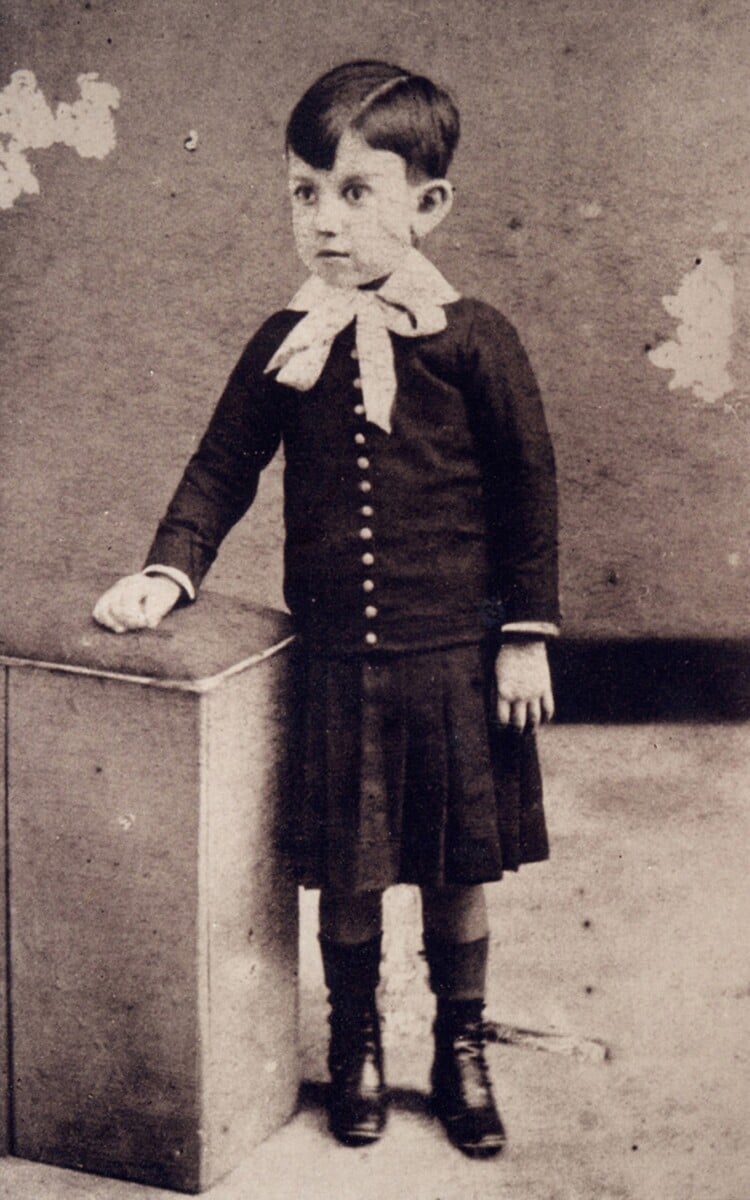
Picasso’s creative abilities began to manifest themselves from early childhood. According to his parents, his first word was “pencil.”
He received his initial lessons in art education from his own father. He taught him the classical academic disciplines of creating copies of paintings by other masters, as well as depicting the human body from real models or plaster casts.
In contrast to his school studies, Picasso showed great interest in these activities. His first oil painting was done at the age of 8, it was called “Picador”.
From 1891 to 1895, the family of the future great artist lived in La Coruña. His father was appointed to the position of art teacher at the art school of this province. One day, observing his son’s drawing technique, Ruiz realized that he was far superior to him.
In 1895, the family decides to move to Barcelona. Pablo’s father went to work at the Academy of Arts. He was able to convince her management to allow her son to take exams to enter this institution. Picasso passed the entrance exams brilliantly, having prepared for them in just one week, instead of the required thirty days. The selection committee unanimously decided to accept him into the academy, although he was only 13 years old at that time.
His father rented him a separate room so he could work and visited him often during the day to look at his drawings. They often argued and swore loudly.
At the age of 16, Picasso went to Madrid to take exams at the Royal Academy of Fine Arts of San Fernando.
Having entered this institution, Picasso soon stopped visiting it, as he did not like the too formal training program.
In Madrid, the future world-famous artist was especially interested in the paintings of Francisco Zurbaran and Diego Velazquez, which were kept in the Prado Hermitage. He visited this museum every day to study the collection of paintings in detail.
But most of all he admired the works of El Greco, which were distinguished by a unique color palette, depicting mysterious faces and long limbs. These elements were later reflected in Picasso’s own paintings.
Career
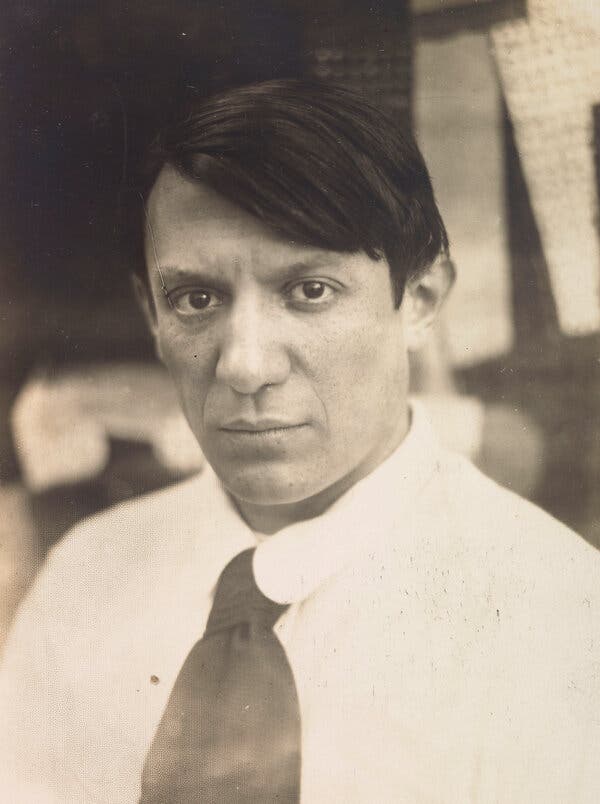
Academic realism is clearly visible in his works of the 90s, for example, in the painting “Portrait of Aunt Pepa.”
Since 1897, together with realism in Picasso’s paintings, symbolism began to manifest itself clearly, due to the presence of green and purple colors in rich unnatural shades.
The period from 1899 to 1900 is characterized by the predominance of modernism. The study of the works of old masters, such as Edvard Munch and El Grec, was subsequently reflected in the work of Picasso of those years.
In 1900, Picasso went to Paris, where he met the French poet Max Jacob. Due to lack of funds and desperate situation, they began to rent an apartment together. At the same time, Picasso worked at night, and Max worked during the day.
Many Picasso paintings had to be burned to keep the small cold room warm.
In 1901, Picasso lived in Madrid for almost six months. There he, together with his friend Francisco de Asis Soler, began publishing the magazine “Young Art”. It published articles, the text for which was written by Soler, and the illustrations were prepared by Picasso. They depicted the terrible living conditions of the poor in a sympathetic manner. The artist began to sign “Pablo R. Picasso” on his own works.
Blue period – from 1901 to 1904
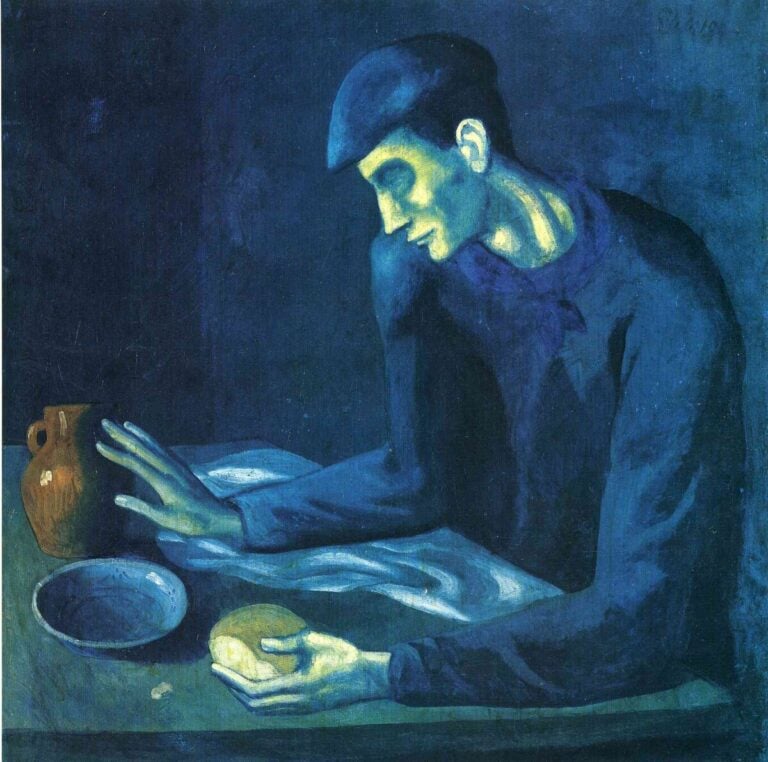
Picasso’s predisposition to use strict colors and choose bleak themes at that time is explained by the influence of the tragic event that happened to his friend Carlos Casagemas, who committed suicide.
Several works by Picasso were dedicated to this sad event. The most allegorical of them is the gloomy painting “Life,” created by him in 1903. It is currently housed at the Cleveland Museum of Art.
The same melancholy motifs permeate the paintings “Mean Lunch”, “Eating Blind”, “Beggar Old Man with a Boy”, “Tragedy”, which depict human suffering.
Other famous paintings of that time include “Portrait of Suzanne Bloch”, “Portrait of Soler”.
Rose period – from 1904 to 1906
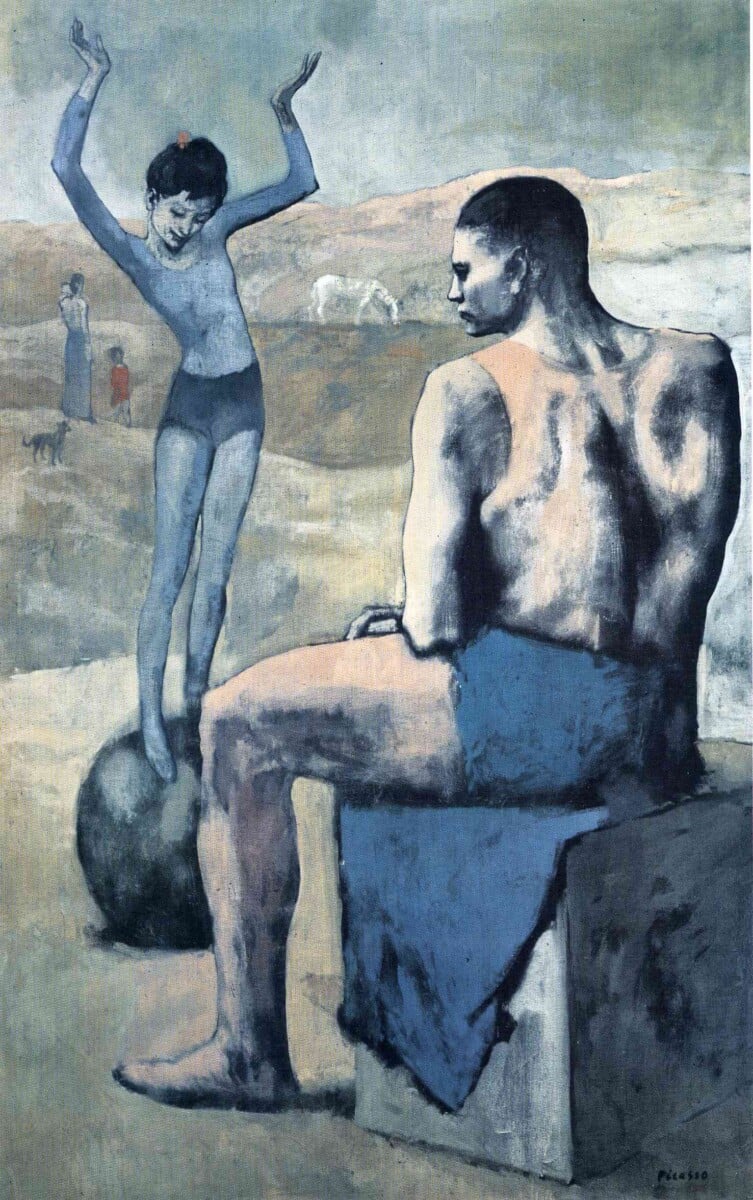
In most cases they depict circus characters. Moreover, “Harlequin” is Picasso’s own symbolic sign. He is usually depicted wearing brightly colored checkered clothing.
In 1904, Picasso, while living in Paris, met the French artist Fernanda Olivier, with whom he began a romantic relationship. All the Parisian paintings he created at this time are filled with optimism and light.
In 1905, he painted the painting “Girl on a Ball,” which is the most striking example of his transitional creative period of those years.
In 1905, Picasso’s works gained incredible popularity among American collectors. Among the most committed of these are the family of Gertrude and Leo Stein. The artist even painted a portrait of Gertrude and her nephew. During this period, Gertrude was Picasso’s main patron. She bought his paintings to exhibit them in her own Parisian painting salon.
Once Picasso met Henri Matisse there. Since then, they have simultaneously become best friends and sworn rivals.
In 1907, in Paris, the German collector and historian Daniel Henri Kahnweiler organized an art exhibition, which was considered the world’s most famous dealer art salon for promoting young artists. Picasso signed a contract with this gallery and began to regularly exhibit his works there.
Primitivism and African art – from 1907 to 1909
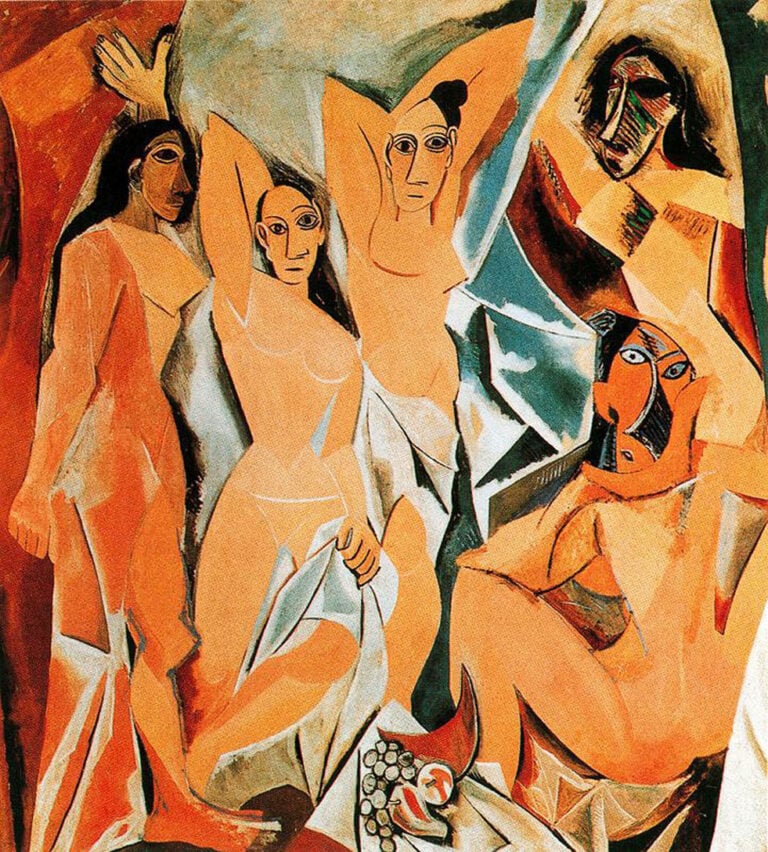
Also, one of the artist’s most striking works of that time is the painting “Three Women.” This period is characterized by a gradual transition from formal subjects to analytical cubism, an artistic style that Picasso invented together with the artist Georges Braque.
It is dominated by neutral color shades and monochrome brown tones. In general, such pictures are perceived as incomprehensible puzzles. Braque and Picasso analyzed various objects, studying their configurations and shapes in detail. The works of these two painters of that time show identical styles and painting techniques. They contain elements of fonts and rough materials.
Gradually, superiority is given to the attributes of bohemian life – smoking pipes, bottles, musical instruments. In addition, the paintings often use “cubist secret writing” – fragments of names of establishments, streets, house numbers or names. (“Guitar and Violin”, “Portrait of a Girl”).
In 1911, Picasso and his friend the poet Guillaume Apollinaire were arrested in Paris on suspicion of stealing the Mona Lisa from the Louvre. After some time, all charges against them were dropped and they were released from custody.
Synthetic Cubism – from 1912 to 1919
At that time, this genre represented cut-out paper fragments (newspapers or wallpaper), which, by gluing together, created certain compositions, which were marked as the first collage trend in art.
From 1915 to 1917, the artist began working on a series of paintings depicting cubist and geometric objects – a glass, a guitar or a pipe with unique collage elements.
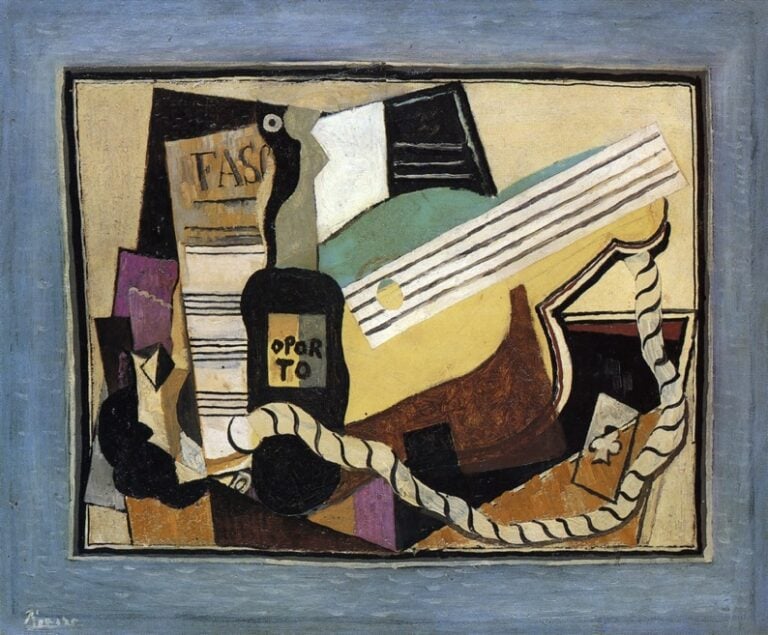
A well-known expert in the field of art criticism called this trend “A square-cut diamond with sharp edges.” When choosing a designation for this movement, Picasso decided to call it “crystal cubism.”
Having become famous and rich, Picasso leaves Olivier for Eva Guell (Marcel Humbé). He expressed his declarations of love to her in an original way, through cubist paintings. However, in 1915, at the age of thirty, Eva died prematurely, which completely devastated the artist.
When World War I began (1914), Picasso lived in France. At the same time, all his friends were mobilized. During this period, the artist works a lot and creates a large number of paintings. However, a significant part of them is permeated with gloomy and sad motives, since his life was filled with dramatic events.
After his expulsion from France, the contract with the Kahnweiler art gallery was automatically terminated. During this period of time, he enters into an agreement with another art dealer agency, Leonce Rosenberg.
In 1918, Picasso married Olga Khokhlova, a ballerina from Diaghilev’s troupe, whom he met while participating in the preparation of Erik Satie’s ballet “Parade” in Italy.
After returning to France, Picasso began collaborating with an art dealer of French-Jewish origin, Paul Rosenberg, who, with his own money, rented the newlyweds an apartment in Paris, not far from his home. This was the beginning of a friendly relationship between Rosenberg and Picasso, despite the fact that they were completely different personalities.
Olga introduced Picasso to influential and wealthy people in Paris. He achieved great success. In his works of that time, preference is given to figurativeness with pronounced cubism (“Mandolin and Guitar”).
Khokhlova and Picasso had a son, Paulo, who later became a motorcycle racer and his father’s personal driver. Picasso, accustomed to leading a bohemian lifestyle, was constantly in conflict with Khokhlova, who demanded that he observe social norms of decency.
While working with Diaghilev’s ballet, Picasso simultaneously collaborated with Stravinsky’s Pulcinella troupe. He even completed several portraits of this composer.
In 1927, the artist met 17-year-old Marie-Therese Walter. A secret romance began between them.
Picasso soon left Khokhlova, but did not divorce her, since according to French law, in this case he was obliged to equally divide the property. The artist categorically refused such a decision. The couple remained married until 1955, when Olga Khokhlova died.
Picasso was in a romantic relationship with Marie-Thérèse Walter for many years. They had a daughter, Maya. At the same time, Maria Teresa in vain flattered herself with the hope of marriage with the artist. 4 years after his death, she hanged herself.
Surrealism and neoclassicism – from 1919 to 1929
In 1917, Picasso visited Italy for the first time. Until this time, he painted in the neoclassical style, associated with the upheavals after the First World War. In the 20s, Picasso’s works were similar to the paintings of Ingres and Raphael.
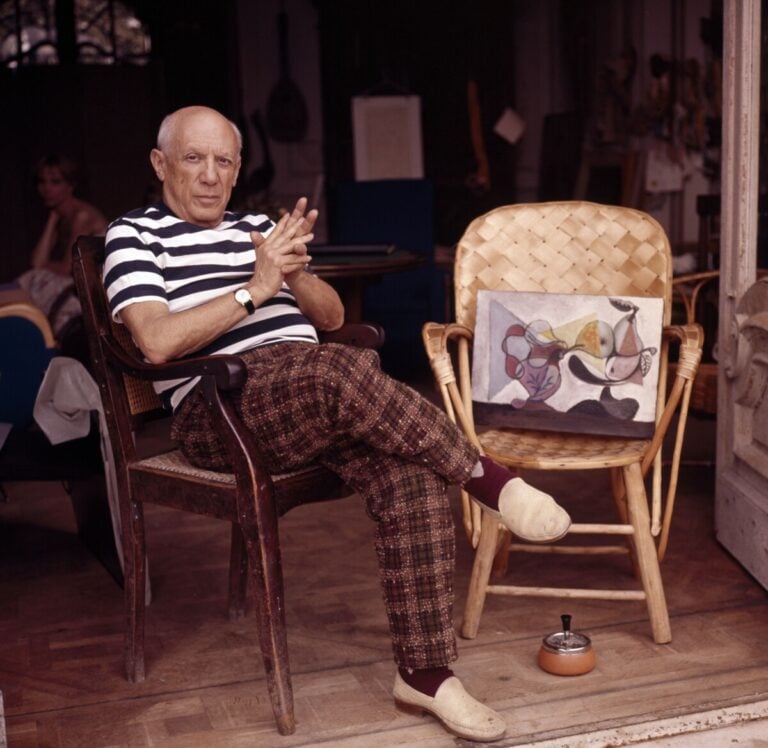
1925 is the most difficult year in the artist’s work. His paintings clearly reveal a world of hallucinations, hysteria and unreality.
The surrealist poet Andre Breton, in his article “Surrealism and Painting,” which was published in the magazine “Revolution Surrealiste,” called Picasso “one of ours.” Illustrations of many of Picasso’s surrealist paintings were published for the first time in this European publication. However, the artist organized a display of his works in the cubist style at the surrealist exhibition in 1925.
During these years, he developed new formats and images for the most accurate expression of emotions, releasing fears and violence, which until 1909 were sublimated in his paintings.
This trend was noted by many experts of the time, including the famous historian Melissa McQuillan. The style of surrealism revived Picasso’s predisposition to primitivism in his work.
During these years, he created several sculptural busts in the spirit of surrealism, the model of which was his wife Maria Teresa Walter. They express the vitality and serenity of the depicted half-real, half-abstract forms.
“The Great Depression” – from 1930 to 1939
In the 30s, the main symbol of Picasso’s work, the “harlequin,” was replaced by him with the “minotaur.” This is due to his in-depth study of surrealism.
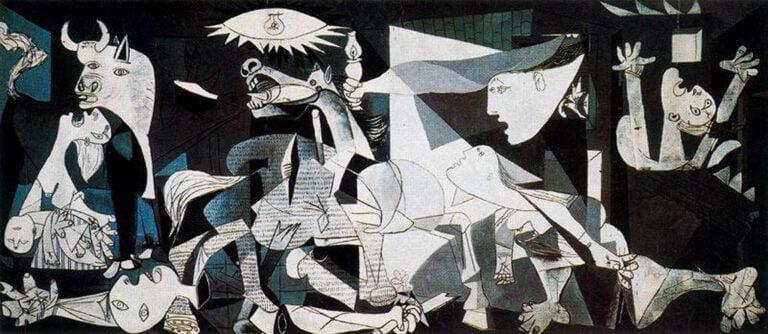
These motifs are used by the artist in the painting “Guernica,” which art critics consider Picasso’s most outstanding work. It depicts the moment of the bombing of the Spanish city of Guernica during the civil war. It is presented in the form of a large canvas, personifying the hopelessness and inhumanity of war.
The painting was exhibited at the international exhibition in Paris in 1937 and subsequently became the main work of an art gallery of 118 works by the most famous artists (Henri Laurens, Matisse and Picasso), which toured England and Scandinavia.
Later, the painting “Guernica” was exhibited in America to raise funds to support refugees from Spain.
This work was in the Museum of Modern Art in New York until 1981. Picasso himself ordered this. He preferred that this picture should return to Spain only with the establishment of democratic and free principles in the country.
In 1940, by order of the head of this museum, Alfred Barr, who was a fan of Picasso’s art, a retrospective of the artist’s main paintings was held. Thanks to this, Picasso became famous in the USA.
At the same time, many art experts were shocked by the duality of Picasso’s works. Some journalists described the artist himself as “vicious and capricious.”
The famous columnist Alfred Frankenstein, in his article published in the Artnews newspaper, called Picasso a person who simultaneously combines a genius and a charlatan.
World War II and the post-war period – from 1939 to 1949
During World War II, Picasso was in German-occupied Paris. He did not exhibit, was often persecuted, and his apartment was often searched.
However, the artist continued to work hard. At that time, he created such famous paintings as “The Crypt” and “Still Life with Guitar.”
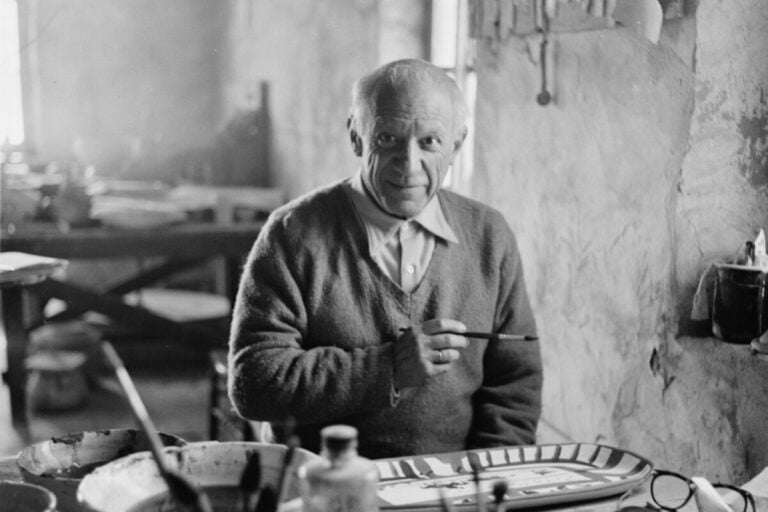
In addition, Picasso began to write poems. Between 1935 and 1959 he wrote about 350 poems. Moreover, most of them do not have a name, but only the date or place of composition. All poems are devoted to a variety of topics and written in different genres.
After the liberation of France, Picasso (at 63 years old) met the young artist Françoise Gilot, who was 23 years old at the time. A romantic relationship began between them. After some time, the couple had children – daughter Paloma and son Claude.
However, due to the artist’s constant infidelities, Françoise left him along with the children. In 1961, Picasso secretly married Jacqueline Roque, with whom they lived together until his death.
By this period of his life, Picasso had a huge fortune, a luxurious Gothic-style house and many villas in France. He gained worldwide recognition. Both famous art critics and ordinary people were interested in his personality and work.
Later works – from 1949 to 1973
In 1949, Picasso participated in the International Sculpture Exhibition in Philadelphia. His stylistic direction changed again with the predominance of modernism. He painted a series of paintings based on the works of Velazquez, Delacroix, Manet and Goye.
In addition, the artist starred in several films, playing himself. For example, in the films “The Testament of Orpheus” and “The Mystery of Picasso”.
He created a 15-meter-tall sculpture in Chicago called “Chicago Picasso.” It is contradictory and ambiguous. It depicts the head of an Afghan hound.
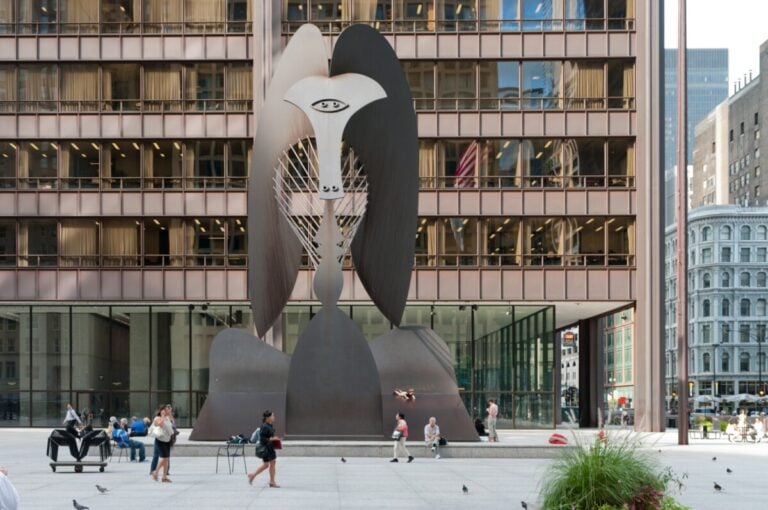
This attraction opened in 1967. At the same time, the artist donated his entire fee in the amount of 100 thousand dollars to the residents of Chicago.
His most recent works were performed in various styles, with constantly changing elements of the emotional reflection of the paintings. Fully devoting himself to creativity, Picasso began to boldly use means of expression and bright color shades.
Between 1968 and 1971 he created many copper engravings. However, most people perceived them at that time ambiguously, as careless artistic sketches. Only after Picasso’s death did the community of art historians come to the conclusion that these works belong to the style of artistic neo-expressionism.
The Death of an Artist
Pablo Picasso died in 1973 on the morning of April 8 in Mougins (France). The cause of death was a heart attack and pulmonary edema.
The artist’s burial is located in his own castle of Vauvenargues, which is located near Aix-en-Provence. They lived in this place with Jacqueline from 1959 to 1962. Picasso’s wife did not allow his children to attend their father’s funeral.
Politics in the life of Picasso
In his youth, the artist expressed support for activists in the Catalan independence movement, but did not take direct part in it.
During World War I and World War II, he did not fight on either side. In 1940, when applying for French citizenship, the government of that country refused him, as they considered him an extremist adherent of communist ideas.
In 1944, the artist joined the ranks of the French Communist Party. In 1948, he attended the International Peace Congress in Poland. In 1950 he was awarded a special Stalin Peace Prize. In 1953, the artist created a portrait of Stalin, which caused critical reviews of this work due to its lack of realism.
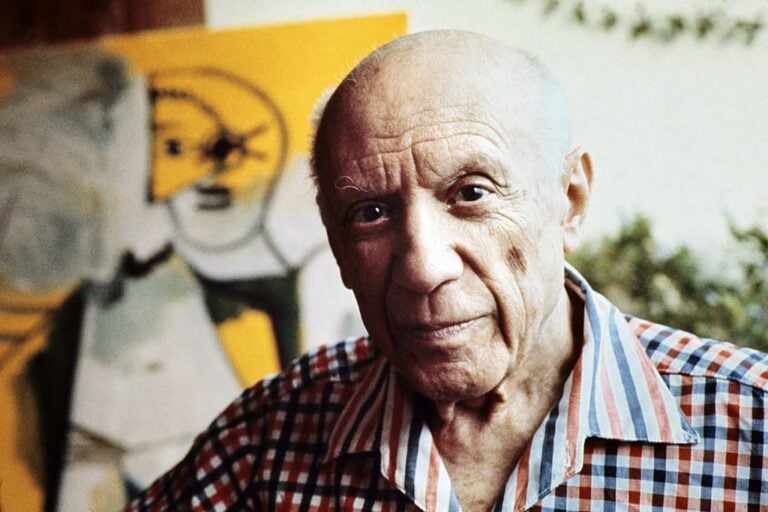
His main art dealer, Kahnweiler, considered Picasso’s joining the Communists to be a “sentimentality” rather than a political decision. However, Picasso himself more than once openly declared his political communist commitment. These statements have often been the subject of debate among the world’s artists and intellectuals. Many of Picasso’s friends did not approve of his communist views.
Picasso did not agree with US intervention in the Korean War. This is reflected in his painting “Massacre in Korea.” Art expert Kirsten Hoving Keane noted that this work is imbued with information about American atrocities and is considered a painting by the artist with the most pronounced communist themes.
In 1949, the artist created the lithograph “Dove” in black and white format. It was used as an image on a poster for the International Peace Council and was classified as a category of iconographic illustration of the time called the “Dove of Peace”. This image served for the world community as a symbolic sign of the congresses of communism and peace.
In 1962, Picasso was awarded the Lenin Peace Prize. At the same time, art biographer John Berger noted that the talent of the artist Picasso was “wasted” on communist commitments.
Technique and style
There were also several thousand prints, as well as carpets and tapestries. The complete catalog raisonné, compiled by expert Christian Zervos, includes 16 thousand drawings and paintings by Picasso.
Picasso’s most significant contribution to painting was made. To create space and form in his paintings, he used a special drawing technique, and he used a color palette as an expressive element. Often the artist added sand to it to correct the texture of the paint.
Following laboratory physical examinations in 2012, Picasso’s use of conventional watercolor paints in many of his paintings was confirmed. Moreover, most of his works were written at night, under artificially created lighting.
The first sculptures of the great master were sculpted from clay or wax, and also carved from wood. Later he created his compositions from various types of materials.
At the beginning of his artistic career, Picasso preferred to use multi-style, universal techniques in one work (for example, in the painting “Cubist Figure in a Chair”).
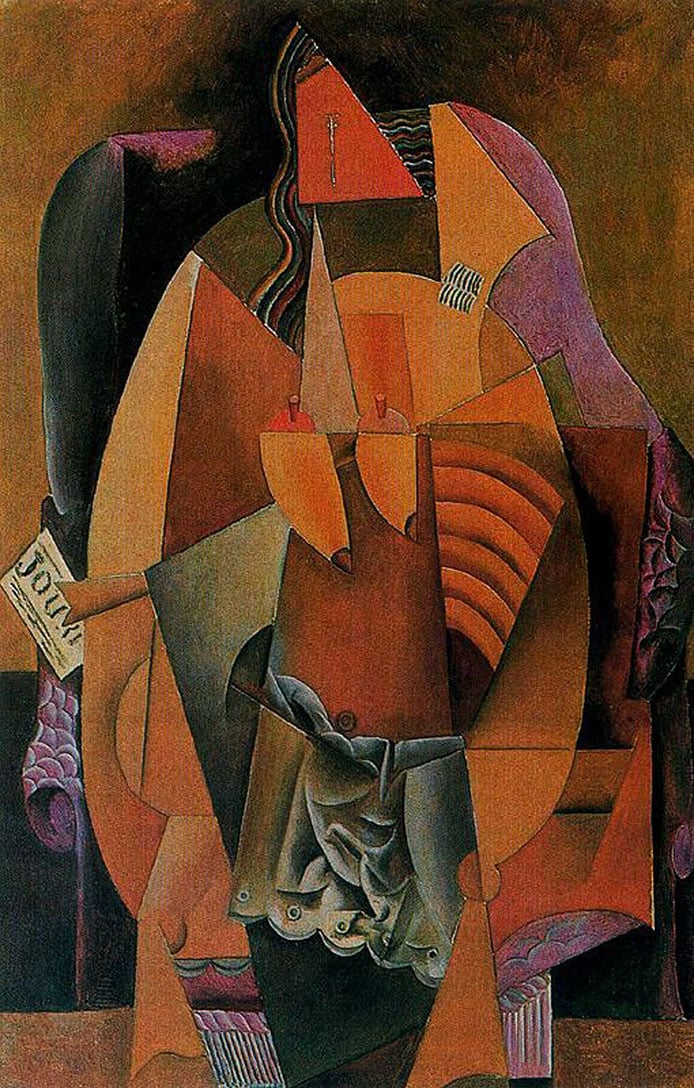
In 1919, he made many drawings from photographs and postcards, thus expressing the static and conventional styles of photographs.
In 1921, he created several neoclassical works simultaneously in different formats (for example, “The Three Musicians”), demonstrating the possibility of a variety of artistic methods of expression.
Despite the closeness of cubist paintings to the abstract style, the artist also preferred to fill them with real objects – for example, bottles, violins or guitars.
Picasso usually depicted complex plot scenes in small-sized drawings and engravings. The only exception is his one such large painting, “Guernica.”
Picasso, unlike the artist Matisse, practically excluded models throughout his creative career. His work is presented in the form of large-scale autobiographical illustrations, based on the concept of inventing new styles at each stage of his life.
In addition, he had the unique feature of dating most of his works in order to maximally document his autobiography for posterity.
Personal life
Picasso’s first wife is Olga Khokhlova. The couple were married from 1917 to 1955, although they had lived separately since 1935. This marriage produced a son, Paulo, who worked as a driver for Picasso. He had three children – Pablito, Marina and Bernard.
The artist’s second wife is Jacqueline Rock. They lived together from 1953 to 1961. The couple raised their adopted daughter Catherine Hutin-Blay and illegitimate children – Maya (from Marie-Therese Walter), Claude and Paloma (from Francoise Gilot).
Olga Khokhlova died of a nervous breakdown, Jacqueline Roque shot herself 13 years after the artist’s death. Son Paulo died due to alcoholism and depression. Pablito’s grandson was poisoned; the cause of this tragedy was Jacqueline Roque’s ban on him attending Picasso’s funeral.
According to experts, Picasso is considered the most “expensive” world artist. In 2021, the artist’s work “Woman Sitting by a Window” was sold at Christie’s auction in the United States for $103 million. It depicted the prototype of Maria Teresa. The starting price of this painting at the auction was $55 million.
